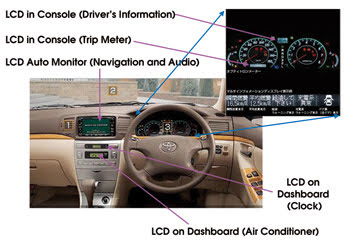Lighting sources for displays continue to adapt new technologies.
Robert L. Donofrio, Display Device Consultants LLC
Automotive displays have come a long way from the analog electromechanical needle moving in front of printed numerals on a contrasting background. The mechanical modification of the indicator dials is a story in itself, with dark lettering on a light background changing to the reverse and back again. More recently, changes have come in the form of employing different light sources and display technologies.
The vacuum fluorescent display has evolved from single cylindrical tubes in 1970 to the thin-film devices used in the automotive industry today. Vacuum fluorescent displays are similar to cathode-ray tubes in that they generate light through electron bombardment of a layer of phosphor.
Moving to digital
In 1985, Buick used a cathode-ray tube to display information on air control, fan speed and radio settings. In 1986, Toyota showed that this type of display could be used for in-car navigation systems. In 1987 and 1989, Toyota and Nissan began using them in cars. The need to provide more information to the driver and the concept of telematics were occurring with the transition to digital electronics.
Digital speedometers, for example, which look like the older analog devices, are pervasive in the industry. Flat panel displays, which have a smaller footprint than the cathode-ray tubes, have become less expensive over the past few years.
Although vacuum fluorescent displays are still used, they are being replaced by new liquid crystal displays (LCDs), LEDs and organic LEDs in the dashboard — where the vehicle speed and warning indicators such as battery condition, oil and tire pressure are displayed. The new devices also are being used in the center console, which contains the radio, environmental controls and navigation (see figure).

Larger liquid crystal display (LCD) panels enable automakers to include more information in the console and instrument panel, with LEDs and organic LEDs providing the visibility needed for a driver to quickly interpret the data while safely navigating the road. Shown here are traditional analoglike gauges along with digital displays of navigational and other information provided on smaller LCDs. Courtesy of DisplaySearch.
In automotive development, new technologies are not implemented until costs fall to an acceptable level. LCDs, for example, are slowly being integrated into cars because the costs are still too high for widespread use. In 2002, Volkswagen showed an instrument cluster with LCD inserts and LED backlights; and Toyota is currently using LCD inserts throughout the instrument cluster and center panel. As prices fall, LCDs should become more prevalent in a broader range of automobiles.
The use of LCD panels rather than the vacuum fluorescent displays in instrument clusters and center consoles enables automakers to pack a great deal more information in the display.
There also is a transition toward using LCDs up to 9 inches in size, which provides room for traditional analog gauges along with additional digital information (see figure). In the future, drivers will be provided with more information through projection systems, head-up displays and other means.
At the same time, the trend toward brighter — yet dimmable — devices will help to make the displays more visible.
Meet the author
Robert L. Donofrio is president of Display Device Consultants LLC of Ann Arbor, Mich.; e-mail: [email protected].